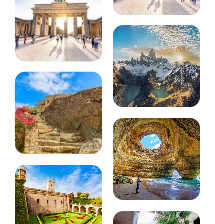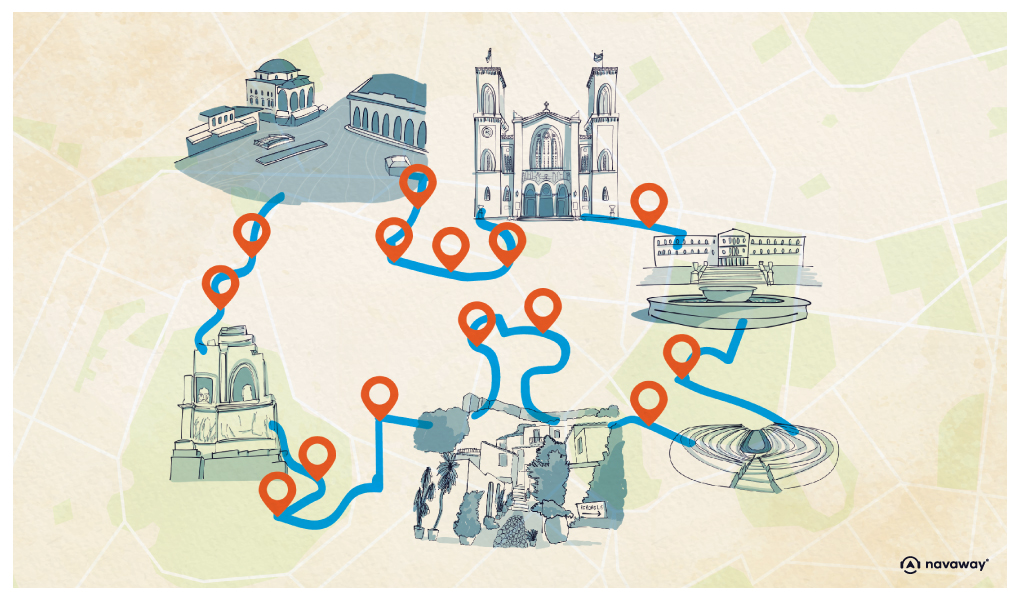
The 20 most beautiful Greek islands to visit

Greece has more than 6,000 islands and islets scattered between the Aegean and Ionian Seas, around 200 of which are inhabited. These Mediterranean gems offer an extraordinary diversity of landscapes, atmospheres and experiences. From the white houses and blue domes of Santorini to the heavenly beaches of Zakynthos, the ancient remains of Rhodes and the unspoilt authenticity of small islands like Folegandros, each destination has its own personality. Some Greek islands have become must-see tourist destinations, while others remain havens of peace untouched by mass tourism. Whether you’re looking for a festive holiday, a chance to immerse yourself in thousands of years of history, nature walks or simply relaxation on dream beaches, the Greek islands will satisfy all your desires to escape under the Mediterranean sun.

Read also about the Greece guide :
- The 10 most beautiful beaches around Athens
- Top 10 things to do in Athens
- Visit the Saronic Islands, off the coast of Greece
- Top 12 culinary specialities in Athens
1. Santorini, the emblematic island of the Cyclades

Santorini epitomises the postcard image of the Greek islands. This volcanic island in the Cyclades is fascinating for its spectacular architecture, with its villages perched on the cliffs of the caldera. Fira, the capital, and Oia, Greece’s most photographed village, offer breathtaking panoramas of the Aegean Sea. White houses with blue shutters line the steep streets, creating a truly magical setting. The sunsets from Oia are legendary, attracting hundreds of visitors every evening to immortalise this exceptional natural spectacle.
As well as its architectural beauty, Santorini is also known for its unique volcanic beaches. Red Beach owes its colour to oxidised lava, while Perissa Beach has black volcanic sand. The island also boasts a remarkable wealth of history, with the archaeological site of Akrotiri, an ancient Minoan city preserved beneath volcanic ash. Wine lovers will appreciate the vineyards cultivated on the volcanic soil, producing unique vintages such as Assyrtiko. Santorini remains a romantic destination par excellence, perfect for a couples’ trip, even if its popularity makes it a very busy island during the high summer season.
2. Mykonos, the festive paradise of the Aegean Sea
Mykonos has established itself as the must-visit party destination of the Greek islands. This pearl of the Cyclades attracts an international clientele who come to enjoy its lively beaches and legendary nightlife. The charm of Mykonos lies in its striking contrast between tradition and modernity. Chora, the island’s capital, is a maze of cobbled streets lined with cubic white houses adorned with bougainvillea. The emblematic windmills overlook the harbour and are one of the island’s most recognisable symbols.
The Little Venice district, with its colourful houses built on the water’s edge, offers a romantic setting where the waves lap at the balconies. The beaches of Mykonos have something for everyone. Paradise Beach and Super Paradise Beach vibrate to the rhythm of beach clubs and international DJ sets, attracting revellers from all over the world. For those seeking more tranquillity, the beaches of Agios Sostis or Fokos, in the north of the island, offer unspoilt, authentic coves. Mykonos is also the ideal starting point for a visit to the sacred island of Delos, a major archaeological site listed as a UNESCO World Heritage Site, where, according to Greek mythology, Apollo was born.
3. Crete, the island of a thousand faces
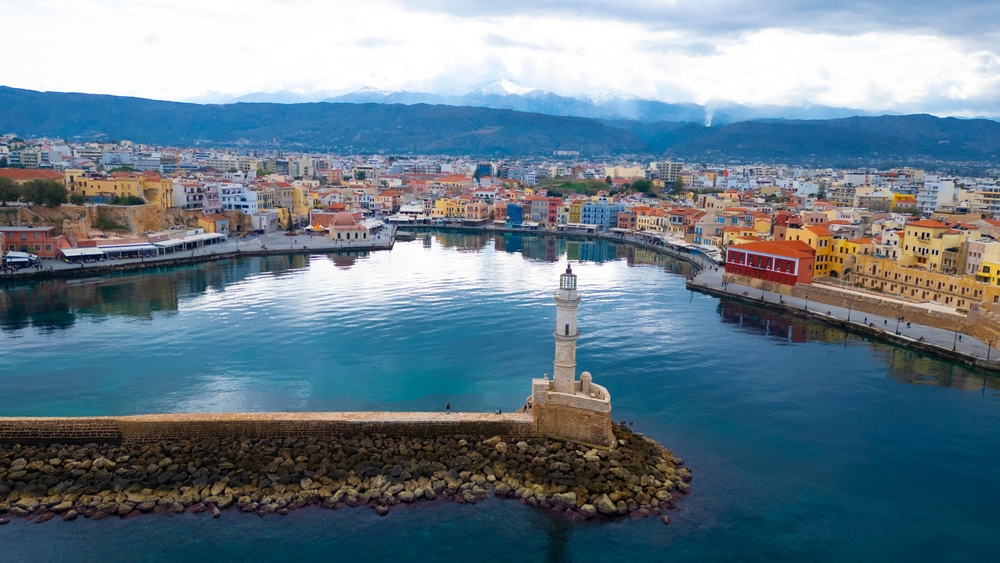
Crete, the largest island in Greece and the fifth largest in the Mediterranean, is so remarkably diverse that it deserves a whole trip in itself. This majestic island is home to an exceptional variety of landscapes, alternating between impressive mountains, spectacular gorges, heavenly beaches and unspoilt traditional villages. The palace of Knossos, near Heraklion, bears witness to the brilliant Minoan civilisation that flourished here over 4,000 years ago. This fascinating archaeological site immerses visitors in the legends of King Minos and the Minotaur, a blend of myth and historical reality.
Crete offers authentic experiences far removed from mass tourism. The 16-kilometre-long Samaria Gorge is one of Europe’s most spectacular hikes, winding its way through a breathtaking canyon before reaching the Libyan Sea. The beach at Elafonissi, with its pink sand and shallow turquoise waters, is one of the most beautiful in the Mediterranean. Cretan towns such as Chania, with its old Venetian port, and Réthymnon, with its fortress overlooking the sea, are captivating for their authentic character. Cretan gastronomy, reputed to be one of the healthiest in the world, will delight your taste buds with its local produce: exceptional olive oil, cheeses with character, thyme honey and sun-drenched vegetables.
4. Rhodes, the island of knights and the sun
Rhodes, the largest island in the Dodecanese, enjoys more than 300 days of sunshine a year, earning it the nickname “Island of the Sun”. The medieval old town of Rhodes, a UNESCO World Heritage Site, is one of the best-preserved medieval ensembles in Europe. Surrounded by impressive ramparts, it was the stronghold of the Knights of the Order of St John of Jerusalem in the Middle Ages. The Palace of the Grand Masters, an imposing Gothic fortress, bears witness to this glorious period. The cobbled streets of the medieval quarter are an invitation to stroll, revealing Ottoman mosques, fountains, craft shops and traditional taverns.
As well as its exceptional historical heritage, Rhodes offers magnificent beaches and a varied landscape. The wilder, windier west coast attracts water sports enthusiasts, particularly kitesurfers and windsurfers. Anthony Quinn’s Bay, named after the Hollywood actor who fell in love with the area, has crystal-clear waters ideal for snorkelling. The village of Lindos, with its acropolis perched on a rocky outcrop overlooking turquoise coves, offers one of the most spectacular views of the Greek islands. The mountainous hinterland of Rhodes reveals authentic villages such as Embonas, famous for its wine, where time seems to have stood still far from the tourist hustle and bustle of the coast.
5. Corfu, the green pearl of the Ionian Sea
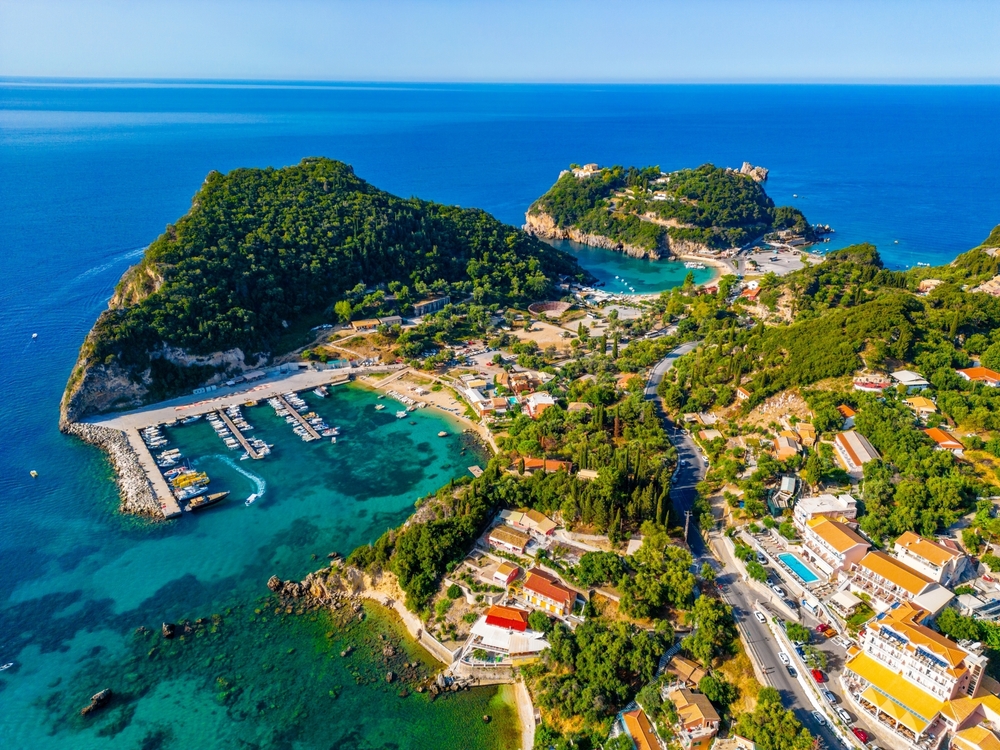
Corfu stands out from the other Greek islands for its lush vegetation, which has earned it the nickname of the Emerald Isle. Olive, cypress and orange trees thrive in the Ionian climate, which is more humid than that of the Cyclades. Corfu’s old town, a UNESCO World Heritage Site, reflects the many Venetian, French and British influences that have marked the island’s history. The two Venetian fortresses, the old and the new, dominate the capital and offer magnificent views of the sea and the nearby Albanian mountains.
The town’s aristocratic architecture, with its elegant Liston arcades inspired by the Rue de Rivoli in Paris, and the Spianada esplanade, one of the largest squares in Europe, give Corfu a unique atmosphere. Corfu’s beaches have something for everyone. Paleokastritsa, in the north-west, is famous for its emerald coves framed by green cliffs. The beach of the Canal d’Amour at Sidari is intriguing for its rock formations sculpted by erosion, creating romantic water passages. The Achilleion Palace, built for Empress Elisabeth of Austria (Sissi), bears witness to Corfu’s appeal to the European aristocracy. Mountain villages such as Pelekas offer spectacular sunsets over the Ionian Sea from their perched positions.
6. Naxos, the largest of the Cyclades
Naxos, often overshadowed by its more famous neighbours Santorini and Mykonos, is well worth a visit for its unspoilt authenticity. This island, the largest and most fertile of the Cyclades, offers a remarkable diversity of landscapes. The inland mountains reach altitudes of over 1,000 metres and are home to traditional villages where cheese and honey are still produced using ancestral methods. The Chora of Naxos welcomes visitors with its imposing Gate of Apollo, the remains of an unfinished temple dating from the 6th century BC, which majestically frames the sunsets.
The Venetian kastro, a fortified district overlooking the harbour, boasts beautiful aristocratic mansions and cobbled streets steeped in history. Naxos boasts some of the most beautiful beaches in the Cyclades, with stretches of fine golden sand stretching for miles. The beaches of Agios Prokopios and Agia Anna are regularly ranked among the most beautiful in Greece. For windsurfers and kitesurfers, Mikri Vigla offers ideal conditions with its steady winds. The mountainous hinterland of Naxos hides unsuspected treasures: the village of Halki with its neoclassical houses, Apiranthos known as the marble village, and numerous hiking trails through olive groves, vineyards and lush vegetable gardens. This agricultural self-sufficiency makes Naxos a destination where the local gastronomy particularly shines.
7. Paros, the beating heart of the Cyclades
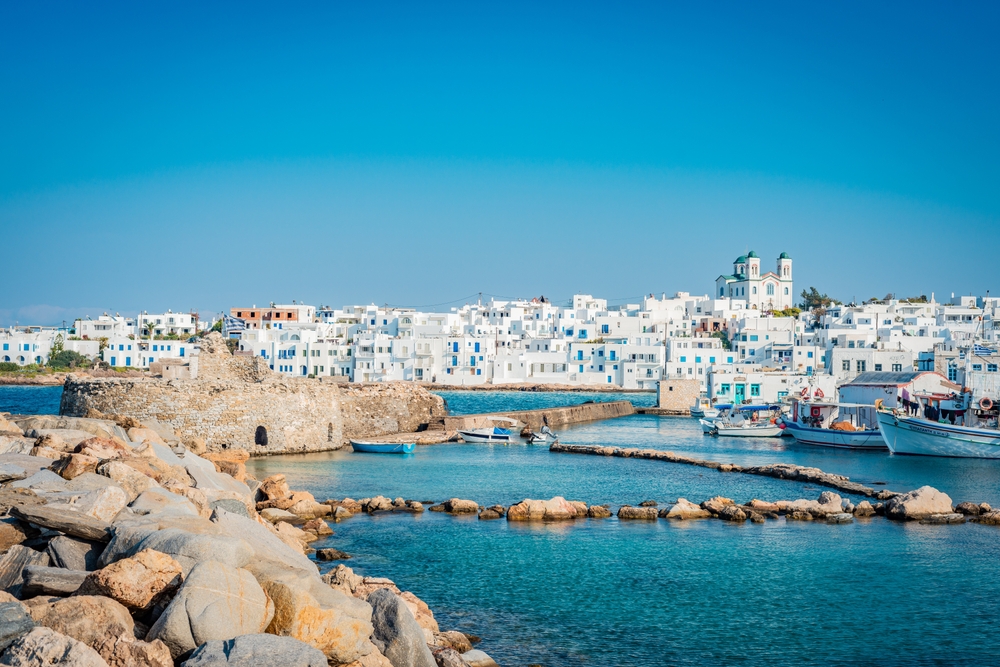
Paros occupies a central position in the Cyclades archipelago, making it a privileged point of passage between the various islands. This island of undeniable charm has managed to preserve its authenticity while developing a high-quality tourist offering. Parikia, the island’s capital, has a lively harbour and whitewashed streets lined with craft shops and cosy tavernas. The Panagia Ekatontapiliani church, one of the oldest Byzantine churches in Greece, impresses with its imposing architecture and history dating back to the 4th century.
Naoussa, in the north of the island, immediately charms with its picturesque little fishing port where colourful boats sway gently. The waterfront restaurants offer freshly caught fish and seafood in a relaxed atmosphere. The beaches of Paros are among the most popular in the Cyclades. Kolymbithres surprises with its rounded granite rock formations that create sheltered natural pools. Santa Maria attracts water sports enthusiasts with its turquoise waters and relaxed atmosphere. Golden Beach, on the east coast, regularly hosts international windsurfing competitions thanks to its optimal wind conditions. Paros marble, famous in ancient times for its whiteness and transparency, was used to sculpt the Venus de Milo and many other major works of classical Greek art.
8. Milos, a volcanic island with spectacular beaches
Milos, nicknamed the Island of Colours, boasts strikingly beautiful volcanic landscapes. This island in the Western Cyclades has long remained untouched by mass tourism, preserving its authentic character. The volcanic geology of Milos has created more than 70 beaches, each with its own unique characteristics. Sarakiniko, with its white rock formations sculpted by wind and waves, resembles a lunar landscape where the contrast with the deep blue water creates a surreal and photogenic setting.
Kleftiko, accessible only by boat, reveals impressive white rocky arches emerging from the crystal-clear waters, creating sea caves where the light plays with the turquoise reflections. The beach at Firiplaka captivates visitors with its multicoloured cliffs, alternating layers of white, red and ochre. Plaka, the main village perched high up, offers panoramic views over the bay and surrounding islands. Fishing villages such as Klima are famous for their syrmata, colourful boatsheds built directly on the water’s edge, which have become one of the visual symbols of Milos. The island also boasts some fascinating historical sites, including the Palaeochristian catacombs and the ancient theatre overlooking the sea. In 1820, Milos was the site of the discovery of the famous Venus de Milo, now on display in the Louvre.
9. Zakynthos, the wild beauty of the Ionian Sea
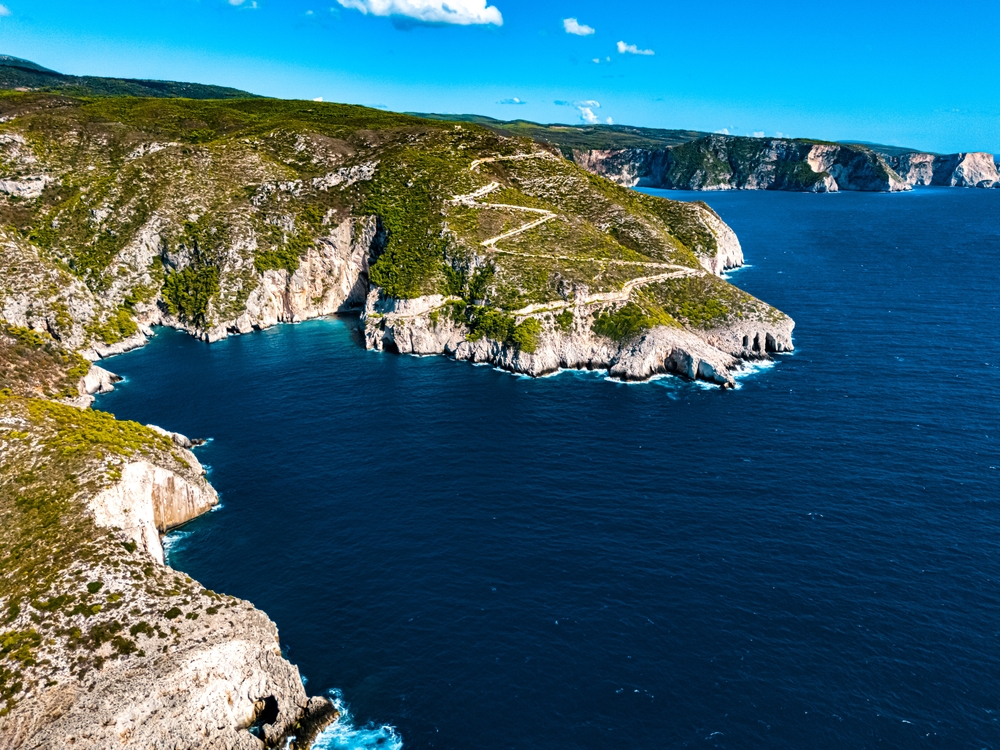
Zakynthos, also known as Zakynthos, is home to one of the most photographed beaches in the world: Navagio Beach, or Shipwreck Beach. Nestling in a spectacular cove surrounded by towering cliffs, this beach of pristine white sand owes its name to the wreck of a ship that has been rusting on the sand since 1980, creating a striking contrast with the turquoise waters. Accessible only by boat, this magical place attracts thousands of visitors every summer, who come to contemplate this picture-postcard landscape from the beach or from lookouts perched on the cliffs.
Beyond Navagio, Zakynthos has other natural wonders. The blue caves in the north of the island fascinate visitors with their electric blue waters, where sunlight creates enchanting reflections in the rocky cavities. The bay of Laganas, to the south, is one of the most important breeding grounds for the loggerhead sea turtle in the Mediterranean, a protected species that can be observed on environmentally-friendly excursions. The beaches of Gerakas and Dafni are closed at night during the nesting season to protect these precious sea turtles. The mountainous interior of Zakynthos reveals traditional villages such as Keri, perched high above the sea, where time seems to stand still. The island’s capital, also named Zakynthos, was rebuilt after the 1953 earthquake in a harmonious neoclassical style.
10. Kefalonia, the majestic Ionian island
Kefalonia, the largest of the Ionian Islands, impresses with its spectacular mountain scenery. Mount Ainos, culminating at 1,628 metres, is a national park home to a unique forest of endemic fir trees, the Abies cephalonica. This rugged island offers striking contrasts between its verdant mountains and its heavenly beaches. Myrtos beach, considered one of the most beautiful in Greece, rolls out its white sand and pebbles at the foot of breathtaking cliffs, creating a grandiose natural amphitheatre where the waters take on breathtaking shades of blue.
The beach at Antisamos, made famous by the film “Captain Corelli’s Mandolin” shot on Kefalonia, enchants visitors with its unspoilt natural setting framed by wooded hills. The geological phenomena of Kefalonia fascinate visitors. The Katavothres abyss, where seawater mysteriously rushes into cavities to re-emerge on the other side of the island, is a unique natural curiosity. The Melissani grotto, an underground lake that is partially open to the sky following the collapse of its vault, is a magical sight when the sun’s rays penetrate the cavity and illuminate the cobalt-blue waters. The village of Assos, considered one of the most beautiful in Greece, nestles at the foot of a rocky peninsula crowned by a Venetian fortress, with its colourful houses reflected in the calm waters of the natural harbour.
11. Kos, the Mediterranean island of Hippocrates
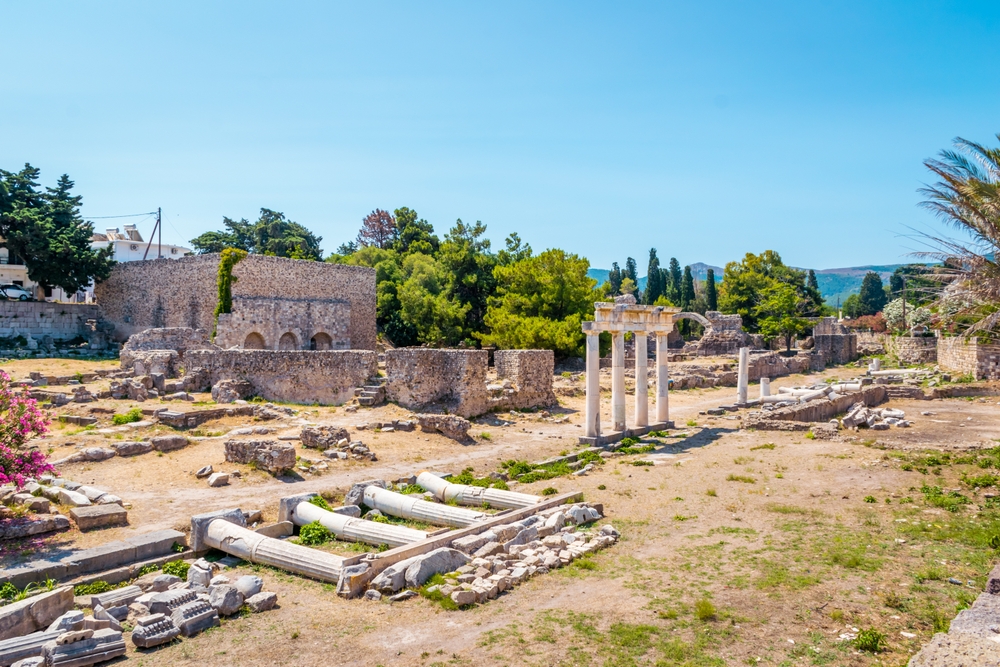
Kos, the third-largest island in the Dodecanese, combines historical heritage, magnificent beaches and a festive atmosphere. This island was the birthplace of Hippocrates, the father of modern medicine, whose presence is commemorated by the legendary plane tree in the town centre, which according to local tradition is over 2,000 years old. Kos is a city steeped in history, with the medieval castle of the Knights of St John, the Asclepion (an ancient health centre dedicated to the god of medicine), and the Roman agora bearing witness to the different civilisations that have left their mark on the island.
Kos’ beaches stretch generously along its 112 kilometres of coastline. Paradise Beach lives up to its name with golden sands and crystal-clear shallow waters, ideal for families. Tigaki and Marmari, in the north of the island, offer long stretches of wind-blown sand, a paradise for windsurfers and kitesurfers. The proximity of Turkey, whose coastline can be seen from Kos, adds an interesting cultural dimension with the possibility of excursions to Bodrum. The island is ideal for exploring by bike, thanks to its relatively flat terrain and numerous cycle paths. Inland villages such as Zia, perched on the slopes of Mount Dikeos, offer a traditional atmosphere and spectacular views over the Aegean Sea, particularly popular at sunset.
12. Hydra, the car-free island of timeless charm
Hydra is the epitome of preserved authenticity, just two hours by boat from Piraeus, the port of Athens. This small island in the Saronic Gulf has made the radical decision to ban cars and motorbikes from its territory, preserving its unique atmosphere and precious calm. You can get around by foot, donkey or water taxi along the coast. This particularity gives Hydra an old-fashioned charm that has seduced many artists, writers and personalities from all over the world. Leonard Cohen lived on the island in the 1960s, finding inspiration in its cobbled streets and bohemian atmosphere.
Hydra’s crescent-shaped harbour provides a theatrical backdrop to the mansions of 18th-century captains climbing the rocky hills. These imposing stone houses, with their sumptuously decorated interiors, bear witness to the maritime prosperity enjoyed by the island at the time. Several of these archontika (mansions) can be visited, such as the Lazaros Koundouriotis house, now a museum. Hydra’s beaches are mainly rocky and accessible by coastal paths or water taxi. Vlychos, Kaminia and Mandraki offer quiet coves with a few traditional tavernas with their feet in the water. In summer, Hydra comes alive with cultural festivals and art exhibitions, adding to its reputation as a cosmopolitan and refined island, where the Athenian intelligentsia like to get away from the hustle and bustle of the city.
13. Ios, a festive island with heavenly beaches

For a long time, Ios was known as the party island par excellence in the Cyclades, a favourite destination for young people who came to enjoy its vibrant nightlife. While this reputation is still very much alive, Ios has managed to diversify its tourist offering, revealing some quieter, more authentic facets too. The Chora of Ios, perched on a hill overlooking the port, is a labyrinth of whitewashed streets dotted with blue-domed chapels. The view from the restored windmills takes in the whole village and the sea, offering memorable sunsets.
The beaches of Ios are among the most beautiful in the Cyclades. Mylopotas beach, a long stretch of golden sand, is the hub of beach bars and water sports, creating a festive atmosphere during the day. For more tranquillity, Manganari beach in the south of the island offers a heavenly setting with its crystal-clear turquoise waters and fine sand, accessible by road or boat. Agia Theodoti, on the east coast, will appeal to those seeking peace and quiet, with its long pebble beach and unspoilt surroundings. Ios also has a special connection with Homer, as tradition has it that the poet chose this island as his final resting place. His supposed tomb can be visited in the north of the island, although its historical authenticity remains debated. This literary connection adds an unexpected cultural dimension to an island renowned for its festive atmosphere.
14. Folegandros, the unspoilt secret of the Cyclades
Folegandros embodies the unspoilt authenticity of the Cyclades, far removed from the mass tourism that has transformed some of its neighbours. This small, rocky, mountainous island has long lived off the tourist beaten track, preserving its traditional character and peaceful atmosphere. The Chora of Folegandros is one of the most beautiful in the Cyclades, clinging spectacularly to the edge of a cliff almost 200 metres above sea level. Its three squares linked by cobbled streets invite you to stroll around in a relaxed atmosphere where time seems to stand still.
The church of Panagia, perched even higher than the village, is well worth the 20-minute climb up a zigzag path, but rewards the effort with breathtaking panoramic views of the sea and neighbouring islands. The sunsets from this highest point are among the most beautiful in the Cyclades. The beaches of Folegandros, although fewer and less accessible than elsewhere, offer wild, unspoilt coves. Katergo, accessible only by boat or via a steep path, reveals a pebbly cove in a spectacular natural setting surrounded by cliffs. Angali is a picturesque fishing village with traditional tavernas and a quiet beach. Agios Nikolaos, the small beach near the port of Karavostasis, offers a convenient option for a quick swim. Folegandros is for travellers looking for authenticity, hiking and tranquillity, away from the hustle and bustle of tourism.
15. Samos, the green island of Pythagoras
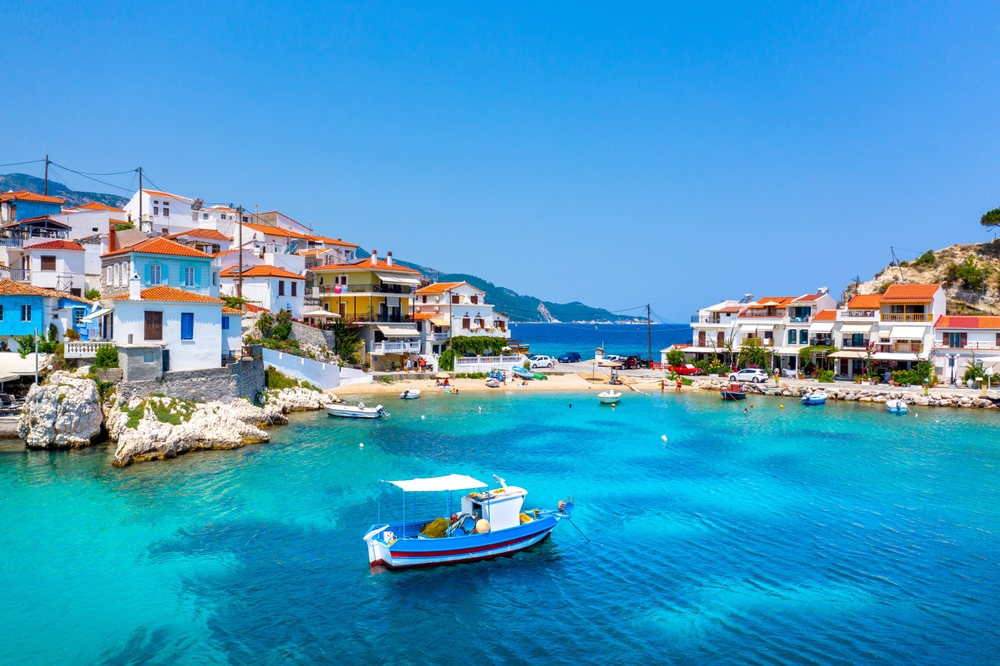
Samos, nestling less than two kilometres off the Turkish coast in the eastern Aegean Sea, is notable for its lush vegetation, unusual for a Greek island. Pines, cypresses, olive trees and vineyards cover its hills and mountains, creating refreshing green landscapes. The island was the birthplace of several great figures of antiquity, including the mathematician Pythagoras and the philosopher Epicurus. The historical heritage of Samos is impressive, with the Herion, a sanctuary dedicated to the goddess Hera and a UNESCO World Heritage Site, of which only one column remains standing, but whose historical importance remains considerable.
The Eupalinos tunnel, a masterpiece of ancient engineering excavated in the 6th century BC, is open to visitors and bears witness to the technical genius of the ancient Greeks. Samos has a wide variety of beaches. Psili Ammos, in the south of the island, offers fine sand and turquoise waters in an unspoilt natural setting. Tsamadou, on the north coast, has a long white pebble beach set in lush green surroundings. Kokkari, a fishing village turned seaside resort, retains its authentic charm with a seafront lined with tavernas serving fresh fish and local specialities. Samos is renowned for its sweet muscatel wine, produced since ancient times and protected by a registered designation of origin. The mountain villages of Manolates and Vourliotes offer a taste of traditional rural life, with their stone houses, century-old plane trees and cool fountains.
16. Patmos, the sacred island of the Apocalypse
Patmos occupies a special place among the Greek islands because of its considerable religious importance. It was in the Cave of the Apocalypse that Saint John is said to have received his revelation and written the book of the Apocalypse, the last book of the New Testament, in the 1st century A.D. This major Christian pilgrimage site attracts believers from all over the world who come to meditate in the cave, which has been converted into a chapel. The monastery of St John the Theologian, an imposing fortress overlooking the Chora, was founded in 1088 and houses an exceptional library containing precious manuscripts and priceless Byzantine icons.
The Chora of Patmos, with its whitewashed houses and labyrinthine alleyways, retains a unique medieval atmosphere. The ensemble formed by the monastery and the historic village is a UNESCO World Heritage Site. Beyond its spiritual dimension, Patmos offers peaceful beaches and magnificent coastal scenery. Psili Ammos, accessible by boat or footpath from Diakofti, offers a stretch of golden sand in an unspoilt natural setting. Lambi, on the north coast, has a captivating array of multicoloured pebbles polished by the sea. Grikos, in a protected bay, offers a family atmosphere with several waterside tavernas. The island attracts a clientele seeking tranquillity, spirituality and authenticity, far from the tourist hustle and bustle of the busier Cycladic islands.
17. Alonissos, an eco-tourism paradise
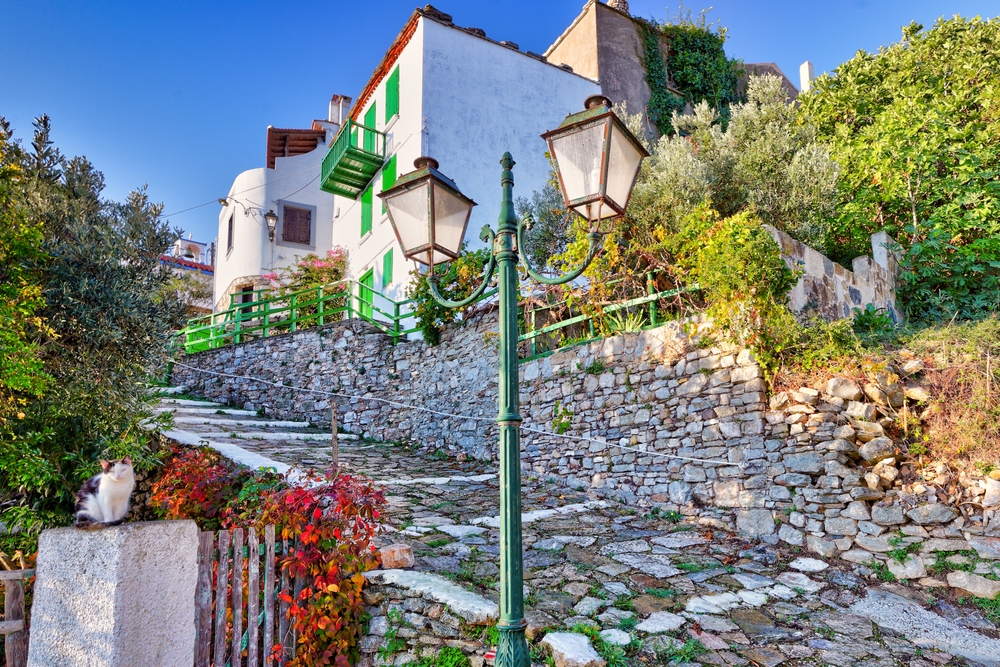
Alonissos, the easternmost island of the Sporades, stands out for its exceptional commitment to environmental protection. The island is surrounded by the Alonissos and Northern Sporades National Marine Park, the largest marine protected area in Europe, created in 1992. This natural sanctuary is home to the Mediterranean monk seal, one of the most endangered species of seal in the world, as well as dolphins, rare seabirds and an exceptionally rich underwater world. Alonissos attracts lovers of unspoilt nature, scuba diving and ecotourism.
The old town of Alonissos, perched on a hill, was abandoned after an earthquake in 1965 and then gradually restored by foreigners seduced by its charm. Today, its cobbled streets, stone houses and flower-filled gardens offer a peaceful atmosphere with spectacular sea views. Patitiri, the main port, is the starting point for excursions to the marine park and the surrounding deserted islands. The beaches of Alonissos, often accessible by dirt track or boat, retain a wild and authentic character. Chrisi Milia enchants with its golden pebbles and crystal-clear waters, while Leftos Gialos offers a long beach in a lush natural setting. The island is ideal for hiking, with a network of paths through pine forests, olive groves and fragrant Mediterranean scrub, revealing landscapes and viewpoints untouched by intensive tourist development.
18. Skyros, the authentic island of the Sporades
Skyros, the largest and most southerly of the Sporades islands, remains largely untouched by conventional tourist routes, preserving a rare authenticity. The island is divided into two distinct parts: the green, fertile north covered with pine and olive trees, and the arid, mountainous south of wild beauty. This geological duality is also reflected in the unique local culture, which blends Cretan, Byzantine and Venetian influences. The Chora of Skyros, built amphitheatrically on a rocky spur dominated by a Venetian kastro and a Byzantine monastery, is a remarkable example of Cycladic architecture, with its white cubic houses climbing the hill.
The cobbled alleyways reveal small, shady squares and craftsmen perpetuating traditional skills, including the manufacture of miniature carved furniture and colourful decorative pottery. Skyros is also famous for its endemic small horses, an ancient, diminutive breed that is said to have inspired the depictions of horses on the Parthenon friezes. These equines graze freely in the mountains to the south of the island. The beaches of Skyros alternate between wild coves and developed bays. Molos and Magazia, near the Chora, offer long stretches of fine sand within easy reach. To the north, Atsitsa and Pefkos offer an unspoilt natural setting. The British poet Rupert Brooke is buried in an olive grove in the south of the island, where he died in 1915 during a military expedition. His grave attracts visitors who come to pay tribute to this figure of English literature in this peaceful setting overlooking the sea.
19. Lefkada, the island accessible by road
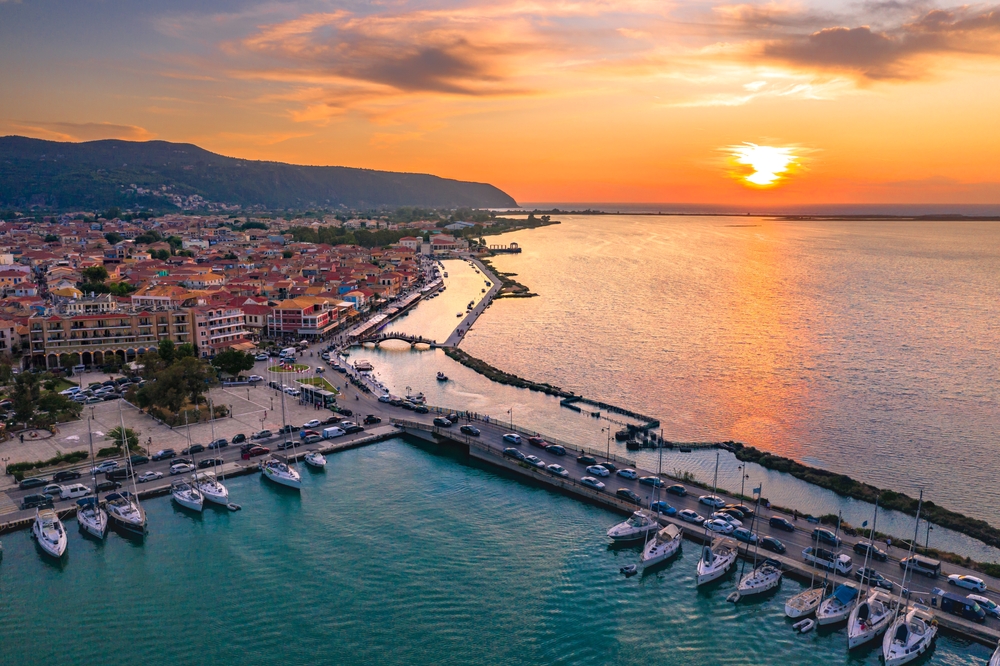
Lefkada, also known as Lefkada, is unique in that it is linked to the Greek mainland by a floating bridge, making it one of the few Ionian islands that can be reached without a ferry. This road connection makes access much easier, while preserving the island’s island character and relaxed atmosphere. Lefkada boasts some of the most spectacular beaches in Greece, if not the Mediterranean. Porto Katsiki beach, on the west coast, regularly features in rankings of the world’s most beautiful beaches, with its towering white cliffs plunging into crystal-clear turquoise waters.
Egremni, accessible by a long staircase or by boat, has almost two kilometres of white sand and pebbles in a magnificent setting surrounded by impressive cliffs. Kathisma beach offers a more accessible alternative, with all the services you need while retaining its remarkable natural beauty. The capital of Lefkada stands out from the other towns on the Ionian Islands for its unique architecture, with colourful houses built of wood and corrugated iron, an anti-seismic solution adopted after destructive earthquakes. This architectural originality gives the town a special charm. Lefkada’s mountainous hinterland reveals traditional villages such as Karya, renowned for its handmade embroidery, and Englouvi, known for its lentils grown at altitude. The Lefkada lagoon in the north of the island is an important protected wetland for birdlife, attracting birdwatchers and nature lovers alike.
20. Ikaria, the island of longevity
Ikaria has gained worldwide renown as one of the world’s ‘blue zones’, those regions where life expectancy far exceeds the global average. A third of Ikaria’s inhabitants reach the age of 90, a phenomenon attributed to the traditional way of life, the local diet rich in vegetables, wild herbs and olive oil, and a relaxed pace of life where stress seems to be absent. This island in the eastern Aegean Sea takes its name from Icarus, the mythological character who fell into the sea after getting too close to the sun with his wax wings. Ikaria cultivates its independence of spirit and its refusal of mass tourism, thus preserving a remarkable authenticity.
The island boasts a spectacular mountainous terrain peaking at over 1,000 metres, with deep gorges, oak and pine forests and thermal springs renowned for their healing properties since ancient times. Therma, a small spa village, attracts visitors who come to enjoy the natural hot baths that spring directly from the beach. The beaches of Ikaria, often wild and unspoilt, appeal to lovers of authentic nature. Seychelles, despite its exotic name, is a long pebble beach with crystal-clear waters on the south coast. Nas, in a secluded bay at the foot of impressive cliffs, offers a spectacular setting with the remains of an ancient temple of Artemis. Mountain villages such as Raches carry on age-old traditions, including the habit of living on staggered hours, with shops opening late and nightlife coming alive after midnight. Ikaria is a destination for travellers in search of authenticity, unspoilt nature and slow tourism, far removed from the standards of conventional seaside tourism.
In conclusion, the Greek islands offer an extraordinary range of experiences and landscapes for all types of traveller. From the iconic Cyclades, with their white houses and blue domes, to the verdant Ionian islands, the history-laden Dodecanese and the small, unspoilt islands of the Sporades, each Greek archipelago reveals its own unique character. Whether you’re looking for the lively festivities of Mykonos or Ios, the romanticism of Santorini, the cultural richness of Crete and Rhodes, the tranquillity of authentic islands like Folegandros or Ikaria, or the natural wonders of Zakynthos and Milos, you’re bound to find the Greek island that suits your fancy. The diversity of the Greek islands means you can put together a tailor-made trip, combining several islands with complementary atmospheres to discover all the facets of this enchanting archipelago bathed by the Mediterranean Sea. The well-developed ferry network makes it easy to travel between the islands, allowing you to explore several destinations in a single holiday and enjoy the magical experience of island hopping, Greek-style, with its thousand-year-old history, heavenly beaches, sun-drenched cuisine and legendary hospitality.
FAQ : The most beautiful Greek islands
When is the best time to visit the Greek islands?
The ideal time to visit the Greek islands is from May to October, with a preference for May-June and September-October to avoid the crowds and excessive heat of July-August. May and June offer pleasant temperatures of around 25°C, more attractive prices and lush green vegetation. September and early October benefit from a warm sea after the summer and a calmer atmosphere as the summer holidaymakers leave. July and August, while guaranteeing maximum sunshine and perfect sea temperatures, are very busy times for tourists, with high prices, particularly on the most popular islands such as Santorini and Mykonos.
How do you get around the Greek islands?
The ferry network is the most popular way to sail between the Greek islands. Companies such as Blue Star Ferries, Seajets and Hellenic Seaways run regular services between the islands, with slower, cheaper classic ferries and more expensive fast catamarans. It is advisable to book in advance in high season. Some islands have airports offering domestic flights from Athens or Thessaloniki, a quicker but more expensive option. The main islands with airports are Santorini, Mykonos, Rhodes, Kos, Corfu, Zakynthos, Crete and a few others. To optimise your itinerary, choose islands in the same archipelago, as connections are more frequent and direct.
How many islands should you plan to visit on a trip to Greece?
For a first trip of one or two weeks, it is advisable to concentrate on a maximum of two to four islands, so that you can make the most of each one without spending too much time in transport. A trip of 10 to 14 days, for example, will allow you to comfortably combine three Cycladic islands (Santorini, Mykonos and Naxos or Paros) with a few days in Athens. For a longer three-week trip, you could consider four or five islands, varying the archipelagos. Bear in mind that each ferry transfer takes time (between 1 and 6 hours, depending on the distance), and that it’s best to stay at least three nights on each island to really get to know the atmosphere and the main sites without constantly having to pack your bags.
Which Greek islands to choose for a family holiday?
For a family holiday with children, opt for islands with sandy beaches, shallow waters, suitable infrastructure and less steep terrain. Naxos is an excellent choice, with its long sandy beaches, picturesque villages and authentic character. Paros also offers beautiful family beaches and a good tourist infrastructure without being too crowded. Corfu, with its lush vegetation and varied beaches, tends to appeal to children. Rhodes offers an excellent combination of history, beaches and activities such as aquariums and water parks. Crete, because of its size, offers a variety of activities, from beaches to accessible archaeological sites such as Knossos, and gorges suitable for family hikes. Avoid very steep islands like Santorini or very festive ones like Ios for a holiday with young children.
Which are the least touristy Greek islands?
To escape the crowds and discover authentic Greece, head for islands like Folegandros in the Cyclades, which has preserved its traditional character. Ikaria, with its unique way of life and reputation as the island of longevity, attracts few conventional tourists. Alonissos in the Sporades offers unspoilt nature and quality eco-tourism away from mass tourism. Samos, despite its proximity to Turkey and its historical heritage, remains relatively uncrowded. Skyros, the southernmost island of the Sporades, retains its authenticity thanks to its relative isolation. Amorgos, Sikinos and Anafi in the Cyclades, and Kassos and Karpathos in the Dodecanese, are among the authentic islands where you can discover traditional Greek island life, far from the tourist hustle and bustle of Santorini or Mykonos.
200 audioguided tours for cities all around the world
Download